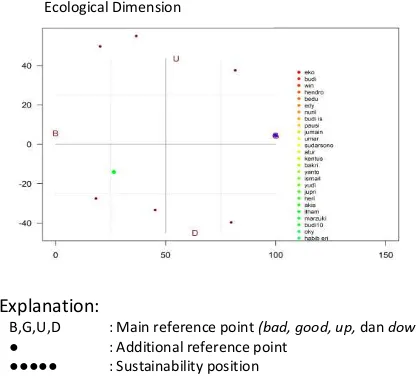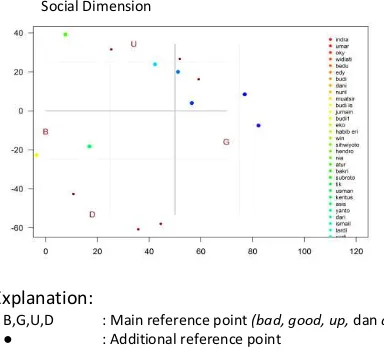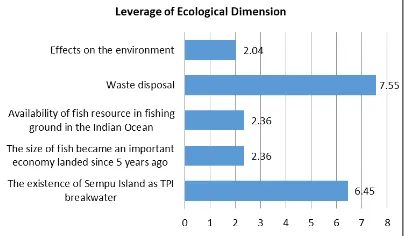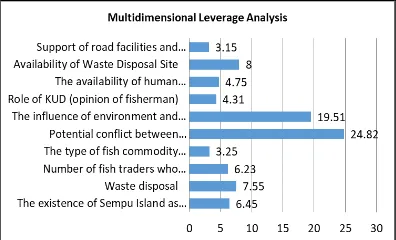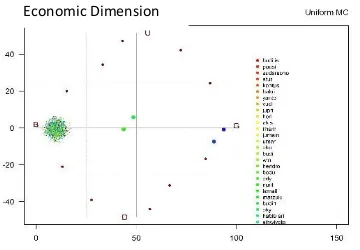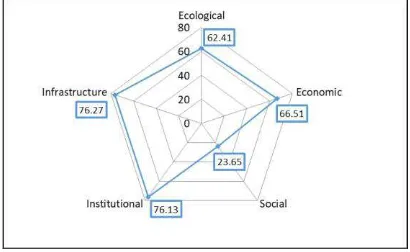Sustainability Level of Management of “Pondok Dadap” Fish Auction Place
to Support Marketing of Marine Fish in Sendangbiru, East Java
Zainal Abidin
1* and Mimit Primyastanto
21,2 Fisheries and Marine Science Faculty, Brawijaya University, Malang, Indonesia
Abstract
This research has aims to analyze the level of sustainability management of fish auction place (TPI) Pondok Dadap. Methods of data analysis using the techniques of Multidimensional Scalling (MDS) through a RAPFISH approach. The results showed that the average index value of sustainability management of fish auction place (TPI) "Pondoddadap" of 61, its meaning is quite sustainable. Each dimension has sustainability index, i.e. the ecological dimension of 62.41%, economic dimension of 66.51%, social dimension of 23.68%, institutional dimension of 76.13%, and infrastructure dimension of 76.27%. The recommended factors to improve the status of sustainability are the availability of places of waste disposal activities TPI or waste treatment installations, an increasing number of fish traders in TPI, keeping the potential conflicts between fishermen and traders so that does not happen, the availability of human resources that support the auction, keeping the role of KUD in the auction, as well as the availability of garbage disposal.
Keywords:sustainability, fish auction, Rapfish, multidimensional scaling, Sendangbiru
INTRODUCTION
The sea area of East Java is almost four times the land area and has a coastline of approximately 2,916Km. Abundant fish resources can support people's food security. The role of the government is very important in the development of the fishery sector, for example by providing a port facility to land fish catches equipped with Fish Auction Places (TPI) to support the marketing of marine fish. According [1], TPI is a functional facility within a fishery port that serves to increase the economic value or use value of basic facilities that can support the activities at the port, as well as places where sellers and buyers make buying and selling of fish by way of auction process.
One of TPI in Malang Regency is TPI at Fishery Harbor (PPP) Pondok Dadap, Sendang Biru, East Java. TPI is one business unit of Village Unit Cooperative (KUD) "Mina Jaya". The institutional function of TPI is to handle the marketing of fisherman catches. The objective of regulating marine fish marketing by the government through establishment of TPI so that the fish marketing process is orderly so that fishermen (seller) and buyer are both beneficial and mutually beneficial, protecting fishermen from price games conducted by middlemen, helping
helping fishermen get a decent price as well assisting fishermen in developing their business.
fishermen get a decent price as well assisting fishermen in developing their business. It is also revealed in [2] that with the existence of TPI, the fishermen can be more free from poverty, and TPI becomes a means to collect retribution by Local Government, and so on. For that reason, TPI plays strategic role in a Fishery Port. It needs effective management to sustain and achieve benefits optimally.
TPI Pondok Dadap in Sendangbiru, Malang Regency has a geographical advantage that is protected from the waves because of the Sempu Island so as to facilitate parking boats at the port and loading and unloading activities of fish, people, tools and supplies to become safer and more comfortable. Implementation of marketing activities through the auction place of fish has the potential of conflict of interest between various parties, such as traders as well as pengambak that have existed before there TPI whose interests are economic motives to gain (economic aspects), local governments with the interests of managing resources and ecology together communities, are also interested in managing auction activities and attracting levies that contribute to PAD to support various policies (economic, institutional, infrastructure, and ecological aspects), and fishing communities with the best interest in selling fish at the best possible price (economic and social). Various
* Correspondence address:
Zainal Abidin
Email: z_abidin@ub.ac.id
Sustainability Level of Management of “Pondok Dadap” Fish Auction (Abidinet al.)
2
conflicts of interest and aspects affect the implementation of the auction in TPI from all aspects of management, thus further affecting the level of sustainability of TPI management "Pondok Dadap". The level of sustainability of TPI management is crucial to determine the role of TPI in improving the marketing of marine fish and increasing the income and welfare of fishermen. Therefore, it is necessary to conduct research on the level of sustainability of TPI management "Pondok Dadap" from all aspects (ecology, economy, social, infrastructure, institutional) to support marketing of sea fish in Sendangbiru, Malang Regency. Thus, the purpose of this study is to analyze the sustainability level of TPI Pondok Dadap management, Sendangbiru. the sustainability level of TPI management "Pondok Dadap" in supporting the marketing of marine fish in Sendangbiru.
Data Collection
Data collection using interview, observation, documentation, and literature study. This research uses primary and secondary data related attribute dimension of sustainability of TPI management. Primary data obtained from
interviews and observation. A thorough
observation of the objects related to the
sustainability of various aspects of TPI
management "Pondok Dadap", i.e. ecology, economy, social, infrastructure, and institutional. From the population of 472 people, 45 respondents were taken to be interviewed consisting of 23 fishermen, 8 wholesalers, 6 TPI managers, 5 UPT fisheries employees, and 3 employees of Mina Jaya KUD selected using disproportionate stratified random sampling method and purposive sampling. Secondary data obtained by documentation and literature study. Documentation study was conducted by linking field data with TPI activity, TPI retribution, fishery production data at TPI Pondok Dadap. The literature study was conducted to underlie research and to sharpen the analysis.
Data Analysis
To answer the objectives of the study used the analysis of sustainability and descriptive qualitative. The analysis of the level of
sustainability of TPI "Pondok Dadap"
management using Multidimensional Scaling (MDS) technique through RAPFISH (Rapid Assessment Technique for Fisheries) approach developed by Tony J. Pitcher and David Preikshot in 2001 at the Fisheries Center, University of British Columbia. According [3], RAPFISH is a rapid appraisal technique designed to allow an
objective, transparent, multi-disciplinary
evaluation.
The RAPFISH method as a statistical technique is used to describe rapidly and accurately the level of resource sustainability by transforming attributes of a multidimensional nature into a simpler dimension. The qualitative descriptive analysis is used to infer the level of sustainable management of TPI "Pondok Dadap" in facilitating the marketing process of sea fish in Sendangbiru. It is also revealed in [4] that the modified RAPFISH method as a multidisciplinary tool for measuring sustainability level of marine and fisferies.
The MDS used in this analysis can be a total metric and nonmetric data score on each variable. Stages of sustainability level analysis: a). the determination of sustainability attributes
depends on the characteristics studied [5], b). assessment of the attributes on an ordinal
scale, scores (values) from field observations, interview results with questionnaire guides, and secondary data. Scoring 1-3 depends on the condition of each attribute and is based on various references, which are then transformed into a score of 1-10. Good values indicate the most favorable conditions for the sustainability of TPI management, and otherwise bad value
means unfavorable conditions for the
sustainability of TPI management [6]. Between the two values there is a middle value. c). Ordinal analysis based on the "multidimensional scaling" method in five dimensions of sustainability, i.e. ecological, economic, social, institutional and infrastructure dimensions. From 5 dimensions in Rapfish analysis there are 29 attributes consisting of 5 ecological attributes, 7 economic attributes, 5 social attributes, and 7 institutional attributes as well as 5 infrastructure attributes. d). The indexing and sustainability levels from 0-100 to four levels of sustainability are based on [6], i.e. 0-25 (bad), 26-50 (less), 51-75 (enough), and 76-100 (good). e). The monte carlo analysis of 76-100 replicates in the RAPFISH method was aimed at
determining the value of sustainability
3 level analysis in the form of low S-Stress value
(<0.25) shows high accuracy, and vice versa [8]; as well as a high R2 value (> 0.90 or close to 1.0) which reflects the dimensions being studied quite accurately (approximate conditions) [9]. g). Leverage analysis to find out which attributes are sensitive to each dimension of sustainability. A total of 1-2 most sensitive attributes (the highest sensitivity value) of each dimension will be selected for multidimensional leverage analysis to determine the sensitivity of selected multidimensional attributes.
Overall phases in sustainability level analysis
of “Pondok Dadap” fish auction management can
be seen at Figure 1.
RESULT AND DISCUSSION
The role of TPI "Pondok Dadap", Sendangbiru Fish Auction Place (TPI) "Pondok Dadap" was built in 1987 as one of the facilities at Fishery Harbor Pondok Dadap in Malang Regency prepared as a center of economic growth of fisheries in the southern region of East Java province, in line with the development of the southern route. This port is geographically very strategic and profitable for tuna fishing business because it is close to the tuna fishing ground, and in the future the transportation infrastructure facilities will continue to be built / prepared by the East Java Provincial Government.
The role of TPI "Pondok Dadap" according to period approved by the auctioneer. According [11], fishery activities in TPI "Pondok Dadap" are:
a) Activities related to production
• Boat hole or boat, load loaded catch
• Distribution of supplies and crew • Maintenance of fishing gear
b) Activities related to management and marketing
• Handling of the catch
Fish auction, packing and distribution
Analysis of Sustainability of TPI Management "Pondok Dadap"
The sustainability of TPI management "Pondok Dadap" is analyzed by MDS method using RAPFISH 3.1 for windows software with R application. Five kinds of dimension to measure the level of sustainability ie ecology dimension (5 attributes), economic dimension (7 attributes), social dimension (5 attributes), dimension
institutional (7 attributes), as well as
infrastructure dimensions (5 attributes).
• Sustainability Level: Ecological Dimension Based on the results of MDS analysis obtained sustainability index value of 62.41. This indicates that the ecological dimension sustainability index on TPI in the category is quite sustainable, as can be seen in Figure 2.
Explanation:
B,G,U,D : Main reference point (bad, good, up, dan down)
● : Additional reference point
●●●●● : Sustainability position
Figure 2. Sustainability Status of the Ecological Dimension
General Condition of “Pondok Dadap”
Fish Auction Management in Sendangbiru
Determining, composing,
Figure 1. Phases and Methods Using MDS
Sustainability Level of Management of “Pondok Dadap” Fish Auction (Abidinet al.)
4
• Sustainability Level: Economic Dimension Based on the results of MDS analysis using Rapfish aid with R application, obtained sustainability index value of 66.51. This indicates that the index of economic sustainability of the economic dimension at the auction site is quite profitable from the economic side or in a sufficiently sustainable state. The results of the analysis can be seen in Figure 3.
Explanation:
B,G,U,D : Main reference point (bad, good, up, dan down)
● : Additional reference point
●●●●● : Sustainability position
Figure 3. Status of Sustainability Economic Dimension
• Sustainability Level: Social Dimension
Based on the results of MDS analysis using Rapfish aid with R application obtained by sustainability index value of 23.68. This indicates that the index of sustainability of social dimension at this fish auction place in bad or unsustainable category because it is in the range of index value 0-25,00. The results of the analysis can be seen in Figure 4.
Explanation:
B,G,U,D : Main reference point (bad, good, up, dan down)
● : Additional reference point
●●●●● : Sustainability position
Figure 4. Sustainability Status of Social Dimension
• Sustainability Level: Institutional Dimension Based on the results of MDS analysis obtained sustainability index value of 76.13. This suggests that the institutional sustainability index of institutional dimensions at fish auction sites is
either good or sustainable. Institutional
conditions in the research area support the sustainability of TPI management "Pondok Dadap”. The analysis results can be seen in Figure 5.
Explanation:
B,G,U,D : Main reference point (bad, good, up, dan down)
● : Additional reference point
●●●●● : Sustainability position
Figure 5. Sustainability Status of Institutional Dimension
• Sustainability Level: Infrastructure Dimension Based on the results of MDS analysis using Rapfish aid with R application, obtained sustainability index value of 76.27. This indicates that the index of sustainability on the
infrastructure dimension related to TPI
management "Pondok Dadap" in either good or sustainable category. The results of the analysis can be seen in Figure 6.
Explanation:
B,G,U,D : Main reference point (bad, good, up, dan down)
● : Additional reference point
●●●●● : Sustainability position
Figure 6. Status of Sustainability Infrastructure Dimension
Infrastructure Dimension Social Dimension
5 Leverage Analysis
According [12], leverage analysis in a study aims to take priority scale. It is also revealed in [13] which states that the leverage result of individual attributes on Rapfish ordinations determines how much each attribute influences in the overall ordination. The highest mean Root Mean Square (RMS) value is the top priority. This is done in determining the steps or policies in the development strategy. The following leverage analysis results from the five dimensions:
Leverage Analysis: Ecological Dimension Based on the leverage analysis of ecological dimension attributes, the attributes that greatly influence the sustainability of TPI management are waste disposal. This is indicated by the attribute's leverage value that is greater than the other attributes. Therefore, It needs improving the sustainability of the ecological dimension to support the sustainability of the management of TPI, a waste disposal site suitable for the fishery waste is needed. In addition, waste processing facilities are also required activities in the TPI. Less available and less functioning of waste disposal facilities cause the appearance of unpleasant odors that interfere with the convenience of TPI activities. The results of the analysis can be seen in Figure 7.
Figure 7. Leverage Analysis of Ecological Dimension
•
Leverage Analysis: Economic Dimension Based on the analysis of leverage on the economic dimension, it is found that the attribute that greatly influences the sustainability index value is the number of fish traders. The number of fish traders present during the auction is only 7 wholesalers, whereas the number of fishermen is large, the market structure that is formed is oligopsoni or leads to an uncompetitive market, although through the auction system.Figure 8. Economic Dimension Leverage Analysis
• Leverage Analysis: Social Dimension
Based on the leverage analysis on the social dimension can be seen that the attributes that greatly affect the sustainability is the potential conflict between fishermen and traders. The results of this analysis indicate that the potential for conflict between fishermen and traders is in the determination of fish prices, but the conflict is likely to occur very small because the base price has been determined through the auction. The result of leverage analysis of social dimension can be seen in Figure 9.
Figure 9. Leverage Analysis of Social Dimension
• Leverage Analysis: Institutional Dimension Based on the leverage analysis on the institutional dimension attribute can be seen that
the attributes that greatly affect the
Sustainability Level of Management of “Pondok Dadap” Fish Auction (Abidinet al.)
6
Figure 10. Leverage Analysis of Institutional Dimension
• Leverage Analysis: Infrastructure Dimension Based on the leverage analysis on the infrastructure dimension, the attribute that most influence the sustainability index value is the availability of garbage disposal. The facts in TPI Pondok Dadap that the availability of waste bins is inadequate, so that quite a lot of fishermen who throw garbage fishing activities into the nearby waters that can cause pollution of marine waters. Therefore it is necessary to increase the number of trash and directed to the fishermen and others not to dispose of waste in the sea waters. The results of the analysis can be seen in Figure 11.
Figure 11. Leverage Analysis of Infrastructure Dimension
• Multidimensional Leverage Analysis
Multidimensional Leverage Analysis in this study is a combined leverage analysis of several dimensions that include 1 or 2 highest attributes in each dimension. The purpose is to know what attributes that most influence the sustainability index. The following shows the results of multidimensional leverage analysis in Figure 12.
Based on Figure 12, that the higher or greater the value of leverage analysis, then the attribute further influence the value of TPI sustainability management index. The highest value of multidimensional leverage analysis shows as the most sensitive attribute in improving the sustainability status of TPI management.
Figure 12. Multidimensional Leverage Analysis
The result of multidimensional leverage analysis shows that the most sensitive attribute can influence the sustainability of TPI Pondok Dadap management is the potential of conflict between fishermen and fish traders in terms of fish price determination. The pricing has caused conflicts during the tender process. But in the research conducted potential conflicts in the determination of fish prices are said to be low or even had no conflict because the lowest price has
been determined by the auctioneer.
Nevertheless, it is necessary to maintain harmony between fishermen and auction sellers.
Monte Carlo Analysis
The monte carlo analysis can be used to examine the magnitude of error factors or errors in sustainability analysis, derived from differences in the assessment of each respondent to
attributes, errors in entering data, and
incomplete or missing data [7] in [14]. It is also revealed by [15] that Monte Carlo analysis utilises a modified inverse Weibull probability distribution function to estimate the possibility of component failures with regard to operating time. Monte Carlo simulation as a random
number generator, which is useful for
forecasting, estimation and risk analysis.
Meanwhile according to [16], if a ‘Monte Carlo’ analysis is a statistical simulation method to evaluate the effects of random error on a
process, and to estimate the ‘true’ value of a
7 analysis of monte carlo in this study was done
100 times repetition, the process of data analysis performed repeatedly quite stable as well as errors in data input and data loss can be avoided. The absence of difference in sustainability index value of monte carlo and Rapfish analysis can be shown in Table 1.
Table 1. Comparison of Sustainability Index Values Monte Carlo and Rapfish.
Dimension of Sustainability
Value of Sustainability Index
Comparison Rapfish Monte
Carlo
Ecological 62.41 62.41 0 Economic 66.51 66.51 0 Social 23.68 23.68 0 Institutional 76.13 76.13 0 Infrastructure 76.27 76.27 0
The results of monte carlo analysis can be seen in Figures 12, 13, 14, 15 and 16 as the output of rapfish analysis with application R. In the figure it is seen that the plot points in the drawing collect or clump at one point, and that means convergent, that the results of ordination in determining the sustainability status of TPI Pondok Dadap stated well and prove the effect of error can be avoided.
Figure 13. Output Monte Carlo Ecological Dimension
Figure 14. Output Monte Carlo Economic Dimension
Figure 15. Output Monte Carlo Social Dimension
Figure 16. Output Monte Carlo Institutional Dimension
Figure 17. Output Monte Carlo Infrastructur Dimension
Goodness of Fit
According [18], to describe the validity of Rapfish statistically with the measurement of R-square (R-squared correlation) values of each dimension. Stress value requirements statistically should be less than 25 percent or 0.25 while R-squared is close to 100 percent or 1. This is comparable [19], that the determination of Stress and Coefficient of Determination (R2) function was to determine whether or not the addition of attributes to reflect accurately the dimensions that were examined (approaching actual conditions). S-Stress value (standard residual sum of square) good is smaller than 0.25 Ecological Dimension
Infrastructure Dimension Institutional Dimension
Economic Dimension
Sustainability Level of Management of “Pondok Dadap” Fish Auction (Abidinet al.)
8
(S <0.25). MDS analysis were stopped if the value of "Stress" has been found the desired requirements, in this case < 0.25 or if the "Stress" does not go down again in the iteration. While [19], revealed that there are, however, far too many points and too much structure for a successful low-dimensional MDS configuration (stress is uncomfortably high, at 0.20).
Rapfish analysis results for Stress and R-Square values can be seen in Table 2.
Table 2. Rapfish Analysis Results for Stress and R-Square Value
Dimension Stress R-Square
Ecological 0.075632 0.951892
Economic 0.115789 0.910895
Social 0.185621 0.810803
Institutional 0.095333 0.926742
Infrastructure 0.093783 0.974304
According to Table 2, the stress values obtained from the five dimensions are smaller than 0.25 and for the R-Square values obtained show values close to 1 or 100%. Thus the results of the sustainability level analysis of TPI management still meet the Goodness-of-fit criteria so it is feasible to be implemented. This is in accordance with [16] in [9], states that the analysis resulted are considered to be accurate and accountable when having a stress value less than 0.25 or 25 percent and the determination coefficient (R2 ) close to a value of 1.0 or 100 percent. This is also in accordance with [20], if the test accuracy of the analysis of MDS (goodness of fit) to the RAP UF analysis coefficient of determination (R2) between 94.78% to 95.36% or greater than 80% or close to 100% mean prediction model sustainability index is very good and adequate use.
Sustainability Index
The results of the measurement of the sustainability of the management of fish auction places (TPI) Pondok Dadap obtained an average of each dimension of sustainability of 61%. In general, the value stated that the management of TPI is quite sustainable. Specifically, there are two dimensions that are sustainable, namely
institutional and infrastructure dimensions
because the index value is above 75, and there are 2 dimensions that are in sustainable condition that is ecological and economic dimension, whereas there is only one dimension that is not sustainable, that is social dimension.
The sustainability index value of each dimension as presented in Figure 17 is ecological dimension of 62.41%; economic dimension 66.51%; social
dimension 23,68%; institutional dimension
76.13%; and infrastructure dimensions 76.27%.
Figure 18. Kite Chart Level of Sustainability of TPI
“Pondok Dadap” Management
CONCLUSION AND RECOMMENDATION Conclusion
The level of sustainability of TPI management "Pondok Dadap" from all dimensions (ecology, economy, social, institutional and infrastructure) is quite sustainable. If seen in each dimension, then there are two dimensions that are in the category of sustainability, namely the dimensions of infrastructure and institutional, while one dimension that is not sustainable is the social dimension. The recommended factors for improving sustainability status are the availability of waste disposal sites for TPI activities or waste treatment plants, increasing number of fish traders in TPI, keeping potential conflicts between fishermen and traders from happening, maintaining the availability and role of human resources supporting auctions, in auctions, as well as the availability of garbage disposal.
Suggestion
As an effort to improve the sustainability status of TPI "Pondok Dadap" management, it is suggested to:
1. The Government of Malang Regency needs to improve the service related to existing activities in TPI Pondok Dadap, especially in managing waste fish auction activities in TPI, for example the procurement of sewage treatment plants and the availability of garbage disposal, and optimization of other supporting facilities in TPI so that fishermen feel comfortable and the quality of catch fish can be maintained.
9 maintain harmony so that economic activity in TPI still running while maintaining cleanliness, order and comfort.
AKNOWLEDGMENTS
The researcher expressed his gratitude to LPPM-UB for its belief in carrying out Research on Beginner Research Hibah (HPP) 2017, field teams that diligently collect research data (Nibrasul Wildan, Rini, Ferik, Khoirulli Ummah dan Iga), and UPT Fisheries- Sendangbiru, Marine and Fisheries Affair of Malang Regency, TPI "Pondokdadap" and KUD "Mina Jaya" Malang Regency.
REFERENCES
[1]. Lumaningsih, Nidya dan Sukardi. 2014.
Rancang Bangun Aplikasi Pendataan
Pelelangan Ikan Berbasis Web pada TPI
(Tempat Pelelangan Ikan) Pacitan.
Indonesian Journal on Networking and Security – ISSN : 2302-5700.
[2]. Pramitasari, Sulistyani Dyah., Anggoro,
Sutrisno, and Susilowati, Indah. 2006. Analisis Efisiensi TPI (Tempat Pelelangan Ikan) Kelas 1,2 dan 3 di Jawa Tengah dan
Pengembangannya untuk Peningkatan
Kesejahteraan Nelayan. Jurnal Pasir Laut, Vol. 1, No. 2, Januari 2006 : 12 – 21.
[3].Pitcher, Tony J and Preikshot, David. 2001. RAPFISH : A Rapid Appraisal Technique to
Evaluate the Sustainability Status of
Fisheries. Fisheries Research 49 (2001) 255 – 270.
[4]. Adiga, M, Suresha., Ananthan, P.S.,
Ramasubramanian, V, and Kumari, Divya. 2015. Validating RAPFISH Sustainability Indicators : Focus on Multi-disciplinary Aspect of Indian Marine Fisheries. Marine Policy 60 (2015) 202-207.
[5]. Alder, J, Pitcher, T.J., Preikshot, D., Kaschener, K, and Feriss, B. 2000. How Good is Good? A Rapid Appraisal Technique for Evaluation of the Sustainability Status Of Fisheries of the North Atlantic. In Pauly and Pither (eds). Methods for Evaluation the Impact of Fisheries Center Research Reports, 2000 Vol 8(2).
[6]. Susilo, Setya Budi. 2003. Keberlanjutan
Pembangunan Pulau-pulau Kecil: Studi Kasus Kelurahan Pulau Panggang dan Pulau Pari, Kepulauan Seribu, DKI Jakarta. Disertasi. Program Studi Pengelolaan Sumberdaya Pesisir dan Lautan. Program Pascasarjana. IPB. Bogor.
[7]. Kavanagh P. 2001. Rapid Appraisal of
Fisheries (Rapfish) Project. Rapfish Software Description (for Microsoft Exel). University of
British Columbia, Fisheries Centre,
Vancouver.
[8].Suwarno, Joko. 2011. Pengembangan
Kebijakan Pengelolaan Berkelanjutan Das Ciliwung Hulu Kabupaten Bogor. Disertasi. Program Studi Pengelolaan Sumberdaya Alam Dan Lingkungan, Sekolah Pascasarjana Institut Pertanian Bogor. Bogor.
[9]. Thamrin., Surjono H. Sutjahjo., Catur
Herison., dan Supiandi Sabiham. 2007. Analisis Keberlanjutan Wilayah Perbatasan
Kalimantan Barat-Malaysia Untuk
Pengembangan Kawasan Agropolitan. Jurnal Agro Ekonomi, Volume 25 No.2, 103-124.
[10].Local Government of Malang. Regulation of
Malang Regent No.1 Year 2009. Local Government of Malang. Malang.
[11]. Abidin, Z., Harahab, N., dan Asmarawati, L. 2017. Pemasaran Hasil Perikanan. Ubpress. Malang.
[12].Kurniawan, R. Fredinan Yulianda, dan
Handoko Adi Susanto. 2016. Pengembangan Wisata Bahari Secara Berkelanjutan Di
Taman Wisata Perairan Kepulauan
Anambas. Jurnal Ilmu Dan Teknologi Kelautan Tropis. 8(1): 367-383.
[13].Murillas, A., Prelezzo, R., Garmendia., Escapa, M., Gallastegui, C, and Ansuategi, A. 2008. Multidimensional and Intertemporal Sustainability Assessment : A Case Study of the Basque Trawl Fisheries. Fisheries Research 91 (2008) 222 – 238.
[14].Wibowo, Arif Budi., Anggoro, Sutrisno, dan
Yulianto, Bambang. 2015. Status
Keberlanjutan Dimensi Ekologi dalam
Pengembangan Kawasan Minapolitan
Bekelanjutan Berbasis Perikanan Budidaya Air Tawar di Kabupaten Magelang. Jurnal Saintek Perikanan Vol.10 No.2 : 107 – 113, Februari 2015.
[15].Rezvani, S., Baverstock, G. F., Urmee, T., Moore, A. D, and Bahri, P. A. 2017.
Techo-economic Ancomparoid Reliability
Sustainability Level of Management of “Pondok Dadap” Fish Auction (Abidinet al.)
10
School of Engineering and Information Technology, Murdoch University, Murdoch, WA 6150, Australia.
[16].Kavanagh, P and Pitcher T.J. 2004.
Implementing Microsoft Excel Software For Rapfish: A Technique For The Rapid Appraisal Of Fisheries Status. Fisheries Centre Research Reports. 12(2). Vancouver (CA): University Of British Columbia. [17].Vajargah, Behrouz Fathi and Salimipour,
Ayoob. 2017. Evaluating Wave Random Path Using Multilevel Monte Carlo. International Journal of e-Navigation and Maritime Economy 7 (2017) 001 – 010.
[18].Nababan, Benny Osta., Yesi Dewita Sari,
Maman Hermawan. 2007. Analisis
Keberlanjutan Perikanan Tangkap Skala Kecil di Kabupaten Tegal Jawa Tengah (Teknik Pendekatan Rapfish). Jurnal Bijak dan Riset Sosek KP. Vol.2 No. 2.
[19].Ratnaningtyas, Nur Afiani., Ma’ruf, Widodo Farid, and Agustini, Tri Winarni. 2016. Prospect and Adversity the Downstream of
“Softbone Milkfish” in Semarang City,
Indonesia. Aquatic Procedia 7 (2016) 166 – 176.
[20].Clarke, K. Robert., Somerfield, Paul J., Airoldi, Laura, and Warwick, Richard M. 2006. Exploring Interactions by Second-stage Community Analyses. Journal of Experimental Marine Biology and Ecology 338 (2006) 179 – 192.
[21].Cahya, Darmawan Listya. 2016. Analysis of
Urban Agriculture Sustainability in
